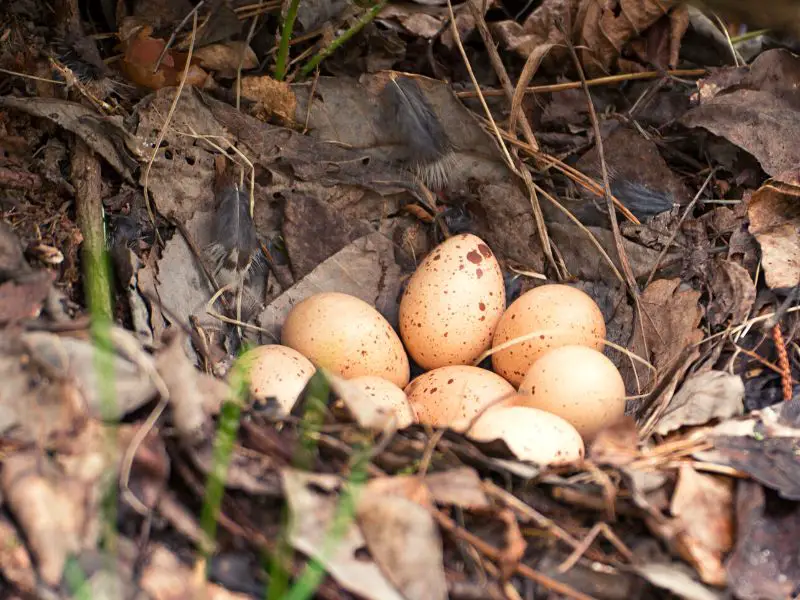Before you head out into the woods to go hunting for wild bird eggs, you might want to double-check your local laws. Hunting songbird and game bird eggs are prohibited in most states in the United States. So getting some old-fashioned wild egg nutrition may only be advisable after doing some research about local laws.
However, if you are starving and come across a non-endangered bird’s nest, you can poach, fry, or hard-boil them to satisfy your hunger. Raw eggs were once considered safe to consume; however, they are frowned upon and deemed unsafe to consume these days.
Learn all about wild egg nutrition and how it can benefit anyone’s diet.

Wild Bird Eggs for Food
It was standard practice to collect wild bird eggs for human consumption for the most part of human history. The good news is that there are no dangerous wild bird eggs to worry about.
Once you’ve found a nest, you should observe the eggs carefully to determine their current stage of development before deciding whether you should eat them or not. This can be accomplished by candling or lighting up the eggs, which is merely shining a light through the eggs. You can do this to many kinds of eggs, however, please note that some bird species lay eggs that are not translucent, so this technique will not work properly on those.
Candles were once used to light the way in the olden days, thus giving rise to the name. As soon as you flashlight through the eggs, you can see if the embryo has developed. A fresh egg will look clear, but when the embryo develops, you will notice a reddish-brown region with blood veins flowing outward from it. If the egg seems dark, you have a whole chick in the egg.
The fact that the embryo is still developing does not prevent you from consuming the egg’s contents. You must be starving or have a strong stomach before attempting this feat. If you are cracking several eggs simultaneously, I recommend you break them first in a separate dish to not contaminate the entire batch if one is bad. Hard-boiling the eggs is a great method to preserve an egg’s calories.
Goose eggs, approximately twice a chicken egg, are the largest egg you can find in the United States. Goose nests are among the easiest to find. However, you must be aware because geese will fight hard to prevent you from taking their eggs. Geese commonly lay eggs in March or April, but it depends on the weather. It takes around 5 weeks for their eggs to hatch. Most wild game and songbirds will lay their eggs during the spring and early summer.

Take some time to observe the birds that inhabit your area, as well as where to find their nesting sites. If you don’t take all their eggs and leave the majority intact, they will continue to lay in the same spot, giving you a long-term supply of wild eggs.
Eggs Nutrition Stats
These egg nutrition stats are for large eggs in general, and should not be taken as advice for all types of eggs.
- 72 calories
- 0g carbohydrates
- 6g protein
- 5g total fat
- 1.5g saturated fat (8% DV)
- 0g fiber
- 0g sugar
- 69mg potassium (1% DV)
- 6mg magnesium (1% DV)
- 28mg calcium
- 0.8mg iron (3% DV)
- 99mg phosphorus
- 0.08mg vitamin B6 (5% DV)
- 0.45 mcg vitamin B12 (10% DV)
- 270 IU vitamin A
- 41 IU vitamin D (11% DV)
Edible Wild Bird Eggs
Eggs are an essential part of any diet, and while there may be some debate on whether they can be eaten raw, wild eggs make a brilliant choice. The wild bird eggs you find should not be harmful to eat and will provide you with a significant number of essential nutrients.

There are many additional species of edible bird eggs available, each with a unique nutritional profile and flavor.
- Chicken eggs
- Goose eggs
- Duck eggs
- Turkey eggs
- Emu eggs
- Pheasant eggs
- Quail eggs
Exploring Wild Egg Nutrition
Wild Egg Nutrition: A Confluence of Unique Ingredients
Wild Egg Nutrition is a comprehensive approach to combining unique and wholesome ingredients, ensuring a balanced diet. It stands as a testament to culinary diversity, integrating elements like fish eggs and saturated fats to create nutrient-dense dishes.
The Essence of Wild Egg Nutrition: Fish and Their Eggs
The inclusion of fish, especially salmon and their eggs, is pivotal in enhancing the richness of wild egg nutrition. Fish eggs, integral to wild egg nutrition, are recognized for their abundance in omega-3 fatty acids, offering a myriad of health benefits, from heart health to cognitive function.
A Closer Look at Wild Egg Nutrition: The Role of Fats and Proteins
Wild egg nutrition places a significant emphasis on the balance of saturated fat and proteins. Egg whites and egg yolks become central to maintaining this balance within Wild egg nutrition, offering a blend of high-quality proteins, healthy fats, vitamins, and minerals.
Savoring Cheesy Goodness with Wild Egg Nutrition
Cheddar cheese is another ingredient that makes Wild egg nutrition distinctive. The incorporation of cheese, particularly cheddar, not only brings a creamy texture and rich flavor but also adds a layer of nutritional value, enriching the dishes under the banner of wild egg nutrition with calcium and protein.
Ethical Choices within Wild Egg Nutrition: Cage-Free Eggs
Cage-free eggs symbolize the ethical and quality choice in wild egg nutrition. Choosing cage-free eggs as an essential component in wild egg nutrition assures consumers of higher quality and ethically sourced ingredients, emphasizing animal welfare alongside nutritional richness.
Wild Egg Nutrition: A Splash of Colors and Flavors
The fusion of colorful vegetables and fruits like avocado, tomato, bell pepper, and red onion contributes to the vibrancy and nutritional diversity of wild egg nutrition. These components, each bringing its unique flavor and nutrient profile, create a harmonious blend within wild egg nutrition, making it a visually appealing and nutritious choice.
Meat Varieties in Wild Egg Nutrition: Balancing Savory Flavors
The savory flavors of turkey bacon, Canadian bacon, and regular bacon are indispensable in wild egg nutrition. These leaner meat options offer a smoky and savory touch to the dishes, enhancing the overall flavor profile of wild egg nutrition while maintaining a balanced approach to fat and calorie intake.
Integrating Carbs and Tanginess: A Wild Egg Nutrition Approach
In wild egg nutrition, the incorporation of sweet and regular potatoes and a dollop of sour cream is crucial. It brings a balanced sweetness and tanginess to the dishes, offering a multifaceted flavor experience, all while contributing essential nutrients and enhancing the overall appeal of wild egg nutrition.
Wild Egg Nutrition as a Culinary Journey
Wild egg nutrition represents a journey through diverse culinary landscapes, each ingredient contributing its unique essence, creating a symphony of flavors and nutrients. From the creamy avocados to the rich salmon eggs, from the tangy tomatoes to the smoky bacon, every element in Wild Egg Nutrition intertwines to offer a balanced, flavorful, and nutritious experience.
Whether one is exploring the creamy richness of scrambled eggs paired with the sweet undertones of orange juice or savoring the nutritious goodness of fish eggs, Wild Egg Nutrition ensures each dish is a celebration of flavors, textures, and nutrients, catering to a variety of palates and dietary preferences, all while prioritizing health and well-being.
Author’s Note
Wild bird eggs are not dangerous to eat and make a perfect choice for a diet that’s looking for diverse nutrients. With that said, there is some debate on whether or not to consume them raw because of their potential contaminants. But the protein and vitamin content are essential for any healthy diet!
We hope this article helps you learn more about wild eggs. Please remember to share it with your friends who might be interested in wild eggs in particular!
Introducing yourself to nut-free candy corn can also satisfy your cravings without compromising your health. You can also add Persian blue salt to your dishes to make them more delicious.

